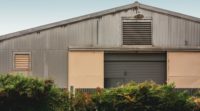Technology Comparison in Metal Roofing Systems

Photo courtesy of AkzoNobel
The world’s demand of Polyvinylidene Fluoride (PVDF) to make high-performance industrial coatings is affecting capacity.
This poses some challenges for the building sector, which is also enjoying growth, where PVDF is used in high-performance coil and extrusion coatings to strengthen the quality, durability, and performance of coating systems.
The pressure on PVDF supplies is being caused by shortages in raw materials, supply chain issues and a rapidly increased demand from the producers of lithium-ion batteries for the electric vehicle (EV) and renewable energy markets. The boom in demand has led to a tripling in prices in recent years.
Architects, specifiers, and manufacturers, including suppliers of coil and extrusion coating systems, view PVDF coatings as the best protection against degradation. Although not commonly used, when they are used, they keep metal roofs on commercial, residential, and agricultural buildings safe and beautiful for 30 to 40 years in harsh environments and are often covered with comparable or even longer warranties than asphalt roofs.
As governments try to replace coal, oil, and gas in favor of solar and wind as their primary source of electricity and encourage a switch to EVs rather than traditional ‘gas guzzlers’ in the automobile sector, demand for PVDF from lithium-ion batteries manufacturers will continue to outstrip supply and prices will keep climbing ever higher.
Faced with these increasing costs, combined with supply chain delays driven by the booming PVDF market, manufacturers and specifiers of coil and extrusion products are facing a dilemma: should they stick with a PVDF-based coating and accept the increased cost and extended timelines that it may bring, or can they use an alternative solution without weakening the quality or durability of the product? This critical decision should be based on a balance of availability, cost, and performance.
Competing Demands for PVDF
PVDF coatings are an option for metal roofing systems. They are often viewed as the premium-tier product in coil and extrusion applications, mainly because they provide exceptional properties around weathering, and thermal and chemical protection. The reason they are so popular for coil coated metal roofing systems in commercial, residential, and agricultural settings is their ability to maintain high performance in even the harshest environments. Other factors include the increase in aesthetic appearance (vs. asphalt) leading to high curb appeal and potential rise in resale value.
However, faced with soaring demand from the more lucrative and fiercely competitive lithium-ion battery market, the global supply of PVDF has become increasingly constrained.
PVDF is used to coat anode and cathode binders in lithium-ion batteries. These battery components are so essential, manufacturers are willing to pay premium prices. And the makers of PVDF are switching to supply these higher-value customers.
Although there is still supply in the market, the challenge for coil and extrusion manufacturers is to protect customers from the risks of delays, higher prices, and future supply.
Suppliers are trying to expand their PVDF production capacity to increase supply, but increasing capacity takes time. In the meantime, it is hard for anyone to know how much more PVDF will be freely available, when it might be available, or how high the price may rise.
In response, architects, specifiers, and coil and extrusion manufacturers are considering alternative coatings that don’t compromise on quality for their customers. PVDF is best suited to harsh environments, such as Florida or other southern U.S. states where roofs are constantly exposed to high levels of heat, humidity, and UV. But advances in alternative coating technology means that non-PVDF coatings now perform just as strongly in more moderate climates. So, when choosing an alternative, what are the things a specifier needs to consider?
Performance
The first consideration is performance, and in particular, flexibility. Coil and extrusion coatings need formability, that is, flexibility, adhesion, and damage resistance. This allows the surface coating to remain intact as metal products are bent or drawn through manufacturing to form various shapes.
The PVDF coating's flexibility supports the manufacture of metal building components. Fluoropolymer coatings are extremely flexible, which prevents the appearance of micro-cracks and abrasions during manufacture. However, this flexible finish can be relatively soft and more susceptible to scratching and marring than other systems. With white coatings, more metal marking occurs than with other, tougher coating systems. Careful handling in production avoids these issues.
Other cheaper systems, like polyurethane coatings, are capable of high levels of flexibility and are commonly used in moderate climates.
Durability
The second thing to consider is durability. PVDF is particularly good for long-lasting protection of vivid and dark colors, although the choice of bright colors is restricted and gloss retention a challenge.
Today's silicone-modified polyester (SMP) coatings are much closer to the durability of PVDF, although they differ slightly in their UV protective qualities. Polyester products offer more moderate UV resistance.
TRINAR, for example, has more recently improved scratching and marring during the forming and cutting processes, during transportation, throughout installation, and over a product’s life. Its adhesive qualities prevent de-lamination of the coating system and protects against corrosion from water, heat, and chemical pollution. Other PVDF resins, such as FEVE, are also tough and scratch resistant, but come at a much higher price.
Harsh Environments
The environment in which the product is to be exposed is also a key consideration. PVDFs are particularly suited to severe environments: industrial sites with high concentrations and quantities of acid rain and chemical pollutants; coastal areas with saltwater spray from the ocean; desert climates with the risk of wind and sand erosion; or climates with extreme heat, UV sunlight, and moisture or humidity, such as South Asia, for example. The vast majority of the Northern Hemisphere, however, does not have such extremes. In these regions, PVDF coatings will offer little additional protection over other high-quality coating systems.
The coating selection criteria varies by project. From experience of SMPs commonly used on metal roofing systems are more than a good substitute in more environments than you would think. Central and Northern U.S., Canada, and North Asia are all examples of areas where PVDF may not be needed.
SMPs will also perform well in other extreme areas, such as coastal areas or mountainous regions with swings in temperature, heavy rainfall, and snow. Although these environments might be considered extreme, SMP's toughness will withstand these conditions well.
Cost Implications
The final issue to consider is cost. The needs of lithium-ion battery manufacturers, and their willingness to pay, means PVDF prices are expected to remain high for some time.
Even if global PVDF production expands, it won’t necessarily fix the problem. As long as there is a supply gap, it is probable that the coatings industry will continue to suffer.
With PVDF in short supply, delivery times, at best, will be longer and, at worst unreliable, which is not good for customer relations. With longer lead times, the price is likely to rise between a customer's order being placed and the product being delivered to them, which requires some careful decisions to be made.
Few projects, if any, are a question of no expense spared. Although PVDF prices have approximately tripled in recent years, FEVE polymers are not an easy substitute as they remain the most expensive high-performance coatings on the market.
SMP coatings are more competitively priced and are not suffering the same supply and fluctuating price issues. They will often be a good alternative to PVDF. Polyester resins are the most economical choice and are commonly used on metal roofing systems in moderate climates.
Choosing the Right Coating
With the supply shortages of PVDF, and a coatings market in transition, coil and extrusion manufacturers must make difficult choices. When trying to produce the best product that meets clients' needs, it isn’t easy to balance performance against availability and cost.
AkzoNobel has prepared an overview of the alternative high-performance coatings available to help manufacturers make that choice. A technical whitepaper and informative videos are available and explains why PVDF resins have such good performance qualities, explores the characteristics of other coating systems, and compares the properties of PVDF products such as TRINAR® to SMP products such as CERAM-A-STAR®. It’s worth noting that CERAM-A-STAR® 1050, industry leading, coil coating system can be used with COOL CHEMISTRY® technology, which contains infrared reflective pigments. These pigments are designed to reflect infrared energy while still absorbing visible light energy, so they stay cooler.
It also compares polyester, polyurethane and FEVE coatings.
There is still so much uncertainty surrounding PVDF capacity and prices. And it is likely to remain for some time. How long is unclear. However, there are already good quality alternatives, like SMPs, and CERAM-A-STAR® 1050, that will deliver the coating performance that most metal roofing projects need.
Looking for a reprint of this article?
From high-res PDFs to custom plaques, order your copy today!




.jpg?height=200&t=1656702490&width=200)
